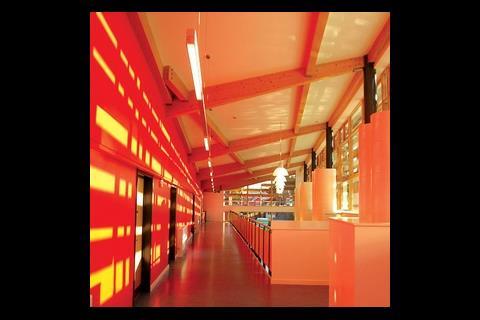A ventilation system that recycles heat generated in classrooms to save energy has been put to the test. Shaun Fitzgerald and Andy Woods go over the results
The growing demand for low-energy buildings has added to the pressure on engineers and manufacturers charged with producing effective ventilation systems for schools. Many new classrooms are planned under the ║├╔½Ž╚╔·TV Schools for the Future programme in England, and this has only increased the need for novel approaches.
The e-stack ventilation method, developed over two years, provides a low-energy system based on the principles of natural ventilation to minimise the fan power used to bring air in and out of a building.
In normal operation, natural ventilation can be energy inefficient in the winter, when cold external air is brought into a building at low level and heated mechanically before entering the occupied space. At the same time, the hot air inside the space is vented to the exterior, thereby losing the heat gain within, some of which could be used to pre-heat the incoming cold air.
The e-stack installation has been designed to recycle the heat generated within the classroom in the winter. This is achieved by mixing the incoming and outgoing air streams at the top of the space, so that the incoming air is pre-heated. In parallel to this thermal control of the inflowing air, the overall flow rate is controlled dynamically using CO2 sensors in the occupied zone. This ensures that, in winter, the interior air quality always remains fresh without using a large amount of energy.
The examination
To judge the potential benefits of the system, the energy required for heating a typical classroom using the e-stack mixing ventilation system was compared with a system whereby the air is pre-heated using a radiator or heating battery on entering the space (figure 1a).
This was tested experimentally in a controlled laboratory setting, using a small air-box measuring 3m x 1.5m x 2m. An electrical heating pad was placed on the base of the test room and the power adjusted to maintain the interior temperature at a pre-defined value in excess of the exterior temperature. The system was run in both mixing and upward displacement ventilation modes, the latter involving an extra electrical heating pad in the low-level inlet.
The difference between the two systems was striking (figure 1b), especially when considering the number of school teaching hours for which the temperature lies in the 5-15┬║C range during a typical year. Combining the hourly weather data over a year in Cambridge, for example, with the energy use in a classroom (figure 1b) we expect that the savings in thermal energy may be about 70-80kWh/m2/yr.
Summer advantage
The incoming and outgoing air streams are mixed at the top of the space, so that the incoming air is pre-heated.
The other benefit of the e-stack system is that in the summer, upflow displacement ventilation can be used by coupling the outflow stack to the inflow through the perimeter openings. This enables effective ventilation of the hot air from the space, thereby minimising any cooling requirement in warm conditions.
A number of new schools have adopted the new strategy for their ventilation and one, Harston and Newton community primary school in Cambridgeshire, had e-stack installed in an existing classroom as a prototype to collect data on performance. It has yielded clear evidence that the system provides ample ventilation throughout the year.
This may be seen from the levels of CO2 monitored in the classroom and also temperature sensors, which indicated that the cold incoming air is effectively pre-heated so that there are no cold draughts. In winter, without a controlled ventilation system, classrooms are often poorly ventilated.
This was demonstrated by a two-week period during which the e-stack system was operating only every other day. The data (figure 2) shows that on the days when the controlled ventilation system was not in operation, the interior CO2 rose to much higher levels; the option of opening windows is not practical because of problems with cold drafts.
Similar positive results have been found with a system installed at Queen Alexandra College, Birmingham, which has been running for 18 months.
Expanding the concept
More recently, the e-stack concept has also been implemented in spaces larger than classrooms. For example, a series of mixing stacks has been designed and installed into the roof of the new 250-seat hall at the Unity College secondary school in Northampton.
This installation was developed by carrying out detailed water bath modelling to explore how a system of stacks interacts. As a result, the Unity system has the facility to operate in mixing mode in the winter while providing ample displacement ventilation in the summer.
The system is now being developed to allow for mixing ventilation in larger buildings, in which a group of classrooms may draw air from an atrium. Initial laboratory model results are encouraging, and the first system is being installed in Port Regis School, Dorset.
Downloads
Figure 1a: Comparison of heating energy requirements for a typical classroom
Other, Size 0 kbFigure 1b: Theoretical predictions (lines) and laboratory measurements (symbols) of heating energy requirements for a model room
Other, Size 0 kbFigure 2: CO2 levels with the e-stack system operating on alternate days
Other, Size 0 kb
Source
║├╔½Ž╚╔·TV Sustainable Design
Postscript
Shaun Fitzgerald is managing director of e-stack ltd. Professor Andy Woods leads the BP Institute for Multiphase Flow at Cambridge University
Original print headline: "Never too cool for school" (║├╔½Ž╚╔·TV Services Journal, June 2008)































No comments yet